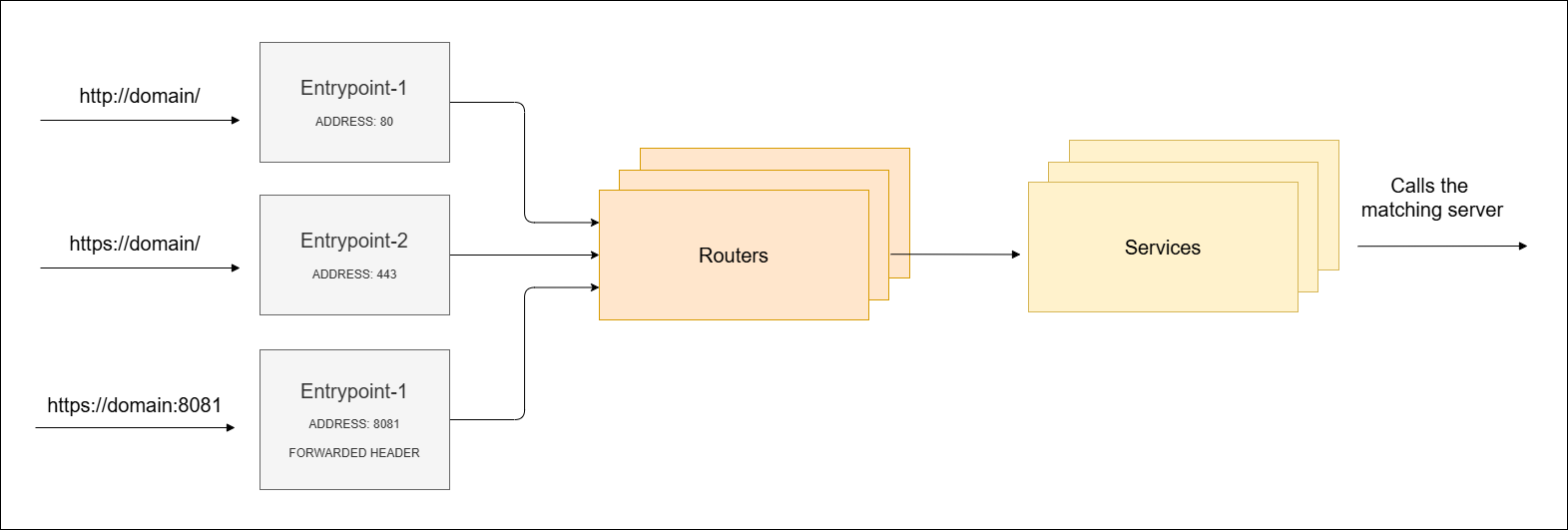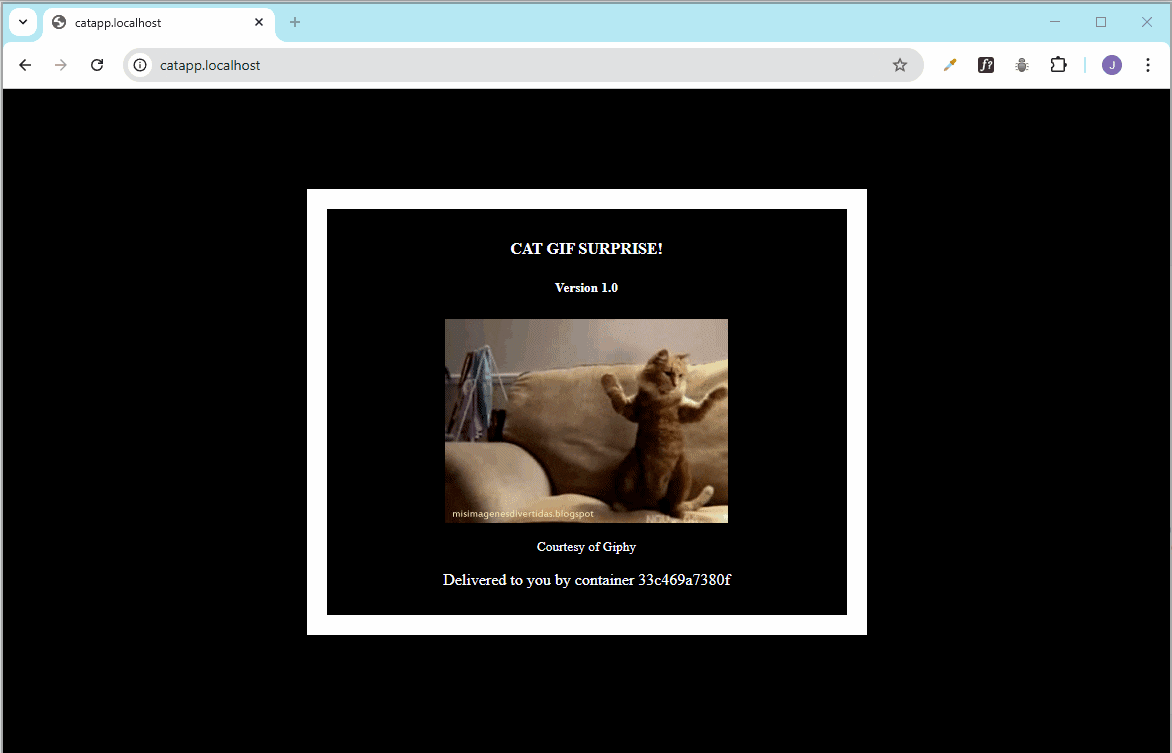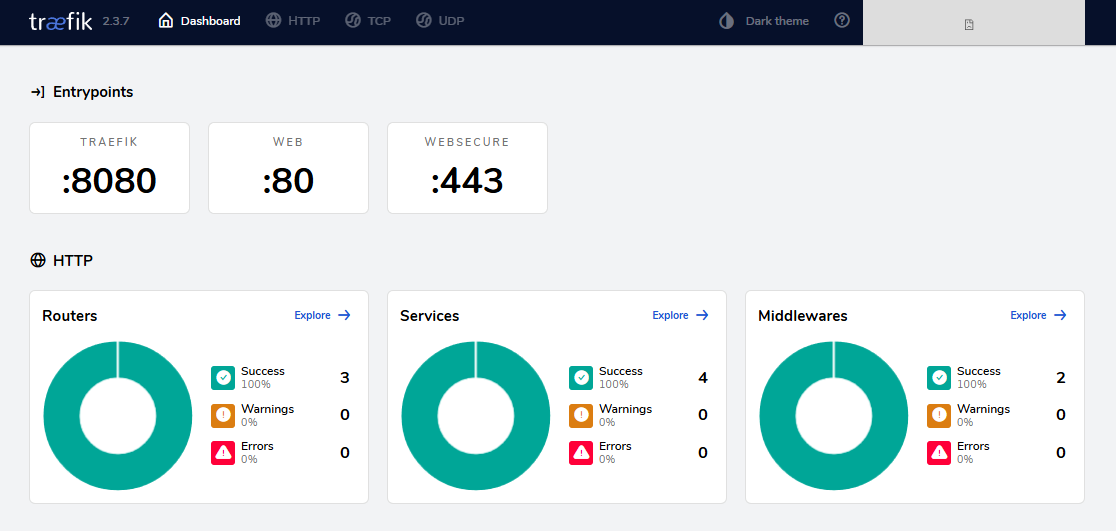Routers
Router Labels
Routers in Traefik connect incoming requests to backend services. To do that, we define rules using labels on containers or services.
- Labels are key-value pairs that guide how traffic is handled.
- Routers use these labels to match requests to services.
- Includes details like protocol, router type, name, and options.
Here’s the basic structure of a router label:
traefik.http.routers.<ROUTER_NAME>.rule
Where:
traefik- Refers to the Traefik service in Docker.http- Protocol being used (could behttp,tcp, orudp).routers- Type of config (can also beservicesormiddlewares).<ROUTER_NAME>- A name you choose (user-defined).rule- The option you’re setting on the router (like matching a path or host).
Example Label:
labels:
- "traefik.http.routers.myapp.rule=Host(`example.com`)"
This means:
"Create an HTTP router named
myapp, and match requests where the host isexample.com."
Router Rules
Routers are how Traefik decides where to send incoming traffic. To control this, we use router rules and define them with labels on your services or containers.
- Rules tell Traefik what to match
- Labels help configure routers automatically
- Routers direct requests to services
Each request comes through an entry point (like port 80 or 443), and routers decide how to handle it based on labels you define. These labels can match hostnames, paths, or other request details.
Here’s a basic router rule label:
labels:
- "traefik.http.routers.myrouter.rule=Host(`myapp.localhost`)"
This label means:
- Protocol:
http - Router name:
myrouter - Rule: Only match requests with host
myapp.localhost
The backticks (" ") are required because Traefik is written in Go, and Go uses backticks to safely wrap string values like URLs or domains.
Default Router Behavior
When you attach a container to Traefik without defining any labels:
- A router and service are created automatically
- The router uses a default rule
- All entry points (like :80, :443) are assigned by default
This might not be ideal. Traefik may expose services unintentionally.
That’s why it’s best to define your own rules, especially for security and clarity.
Limiting Entry Points
By default, routers accept all entry points unless you specify otherwise.

You can control which ports are used by setting the entrypoints option:
labels:
- "traefik.http.routers.myrouter.entrypoints=web"
This ensures the router listens only on the web entry point, which is usually port 80.
Router Configurations
You can fine-tune router behavior further using these labels:
-
Router Rule
Rules tells Traefik what to match:
- "traefik.http.routers.myrouter.rule=Host(`abc.com`)" -
Entrypoints
Controls which port the router listens to:
- "traefik.http.routers.myrouter.entrypoints=ep1,ep2" -
Define Service
If needed, specify the backend service name:
- "traefik.http.routers.myrouter.service=myservice" -
Enable TLS
Control HTTPS usage:
- "traefik.http.routers.myrouter.tls=true"When TLS is enabled, the router will only accept secure connections.
Clone the Repository
To try out the examples, clone the project repository from GitHub.
- Github repo: joseeden/labs-traefik
Clone and move into the project directory:
git clone https://github.com/joseeden/labs-traefik.git
cd labs-traefik/03-routers-and-services
Project structure:
03-routers-and-services
.
├── docker-compose.yml
└── traefik.yml
Lab: Cat App Router
Inside the lab directory, we have the docker-compose.yml file. It contains sample router setup for an app that runs on port 5000:
version: "3"
services:
traefik:
image: traefik:v2.3
ports:
- "80:80" # web requests
- "8080:8080" # Traefik dashboard
- "443:443" # HTTPS requests
volumes:
- /var/run/docker.sock:/var/run/docker.sock
- ./traefik.yml:/etc/traefik/traefik.yml
catapp:
image: mikesir87/cats:1.0
labels:
- "traefik.enable=true"
- "traefik.http.routers.catapp.rule=Host(`catapp.localhost`)"
- "traefik.http.routers.catapp.entrypoints=web"
- "traefik.http.routers.catapp.service=catapp"
- "traefik.http.services.catapp.loadbalancer.server.port=5000"
This configuration tells Traefik:
- Only handle requests for
catapp.localhost - Use the
webentry point (port 80) - Forward traffic to the
appservice - Use port 5000 inside the container
Apply the files:
docker stack deploy -c docker-compose.yml traefik
Output:
Creating network traefik_default
Creating service traefik_traefik
Creating service traefik_catapp
After deploying, you can access the app at:
http://catapp.localhost

You can also check your setup in the Traefik dashboard.
http://localhost:8080
It will show:
- The router name (
catapp) - The matched host rule
- The assigned service and entry point
This helps confirm everything is working as expected.
Cleanup
To remove the resources:
docker compose -f <CONFIG_FILE_PATH> down
To check all stacks in your Swarm:
docker stack ls
To remove the specific stack:
docker stack rm <STACK_NAME>
To remove all stacks currently deployed in your Swarm:
docker stack ls --format '{{.Name}}' | xargs -r docker stack rm
Resources
Traefik’s documentation has two key places to check:
-
Routers (General) For basic routing examples and behavior: https://doc.traefik.io/traefik/routing/routers/
-
Routers for Docker Provider For Docker-specific label usage: https://doc.traefik.io/traefik/providers/docker/#router-configuration
